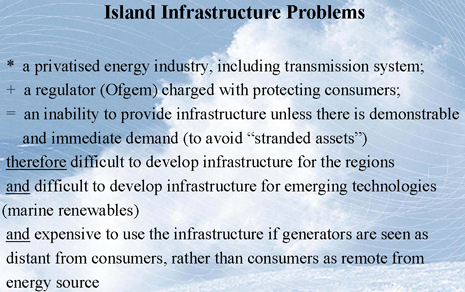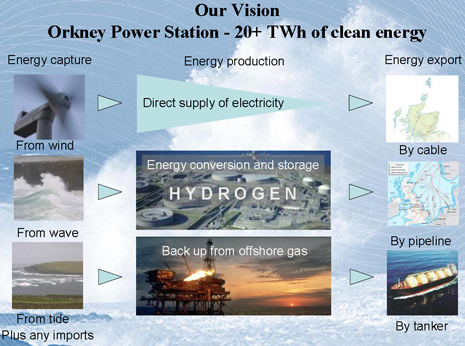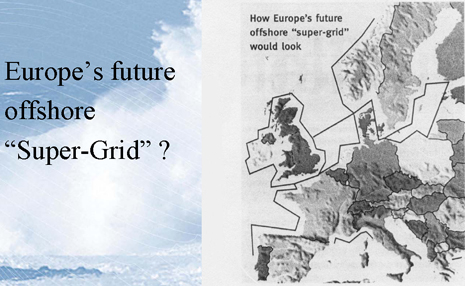 |
Micro grid OrkneyLaatste geactualiseerd op 30 november 2009Het Schotse Orkney bevindt zich aan het einde van het gecentraliseerde elektriciteitsnet. Tegelijk is het het centrum van off-shore elektriciteitsproductie. Volgens de eilanders moet het net dus worden omgekeerd. Niet van kern en kolencentrales, uiteindelijk naar Orkney. Maar duurzame energie van Orkney naar het vaste land van Schotland.
Het probleem van OrkneyHet probleem van Orkney laat zich kort samenvatten: de vanuit Europa geinstigeerde 'liberalisering' en marktordening verhindert de verduurzaming van de elektriciteitsvoorziening. Klinkt dat bekend?
De visieDe eilanders hebben een visie. Het liefst zouden ze de hele EU van duurzame zee-energie voorzien.
Off-shore super gridDus lanceren ze het idee van een off-shore supergrid. Niet geheel toevallig ligt Orkney op de route.
EU subsidieDe EU wil natuurlijk niet in een kwaad daglicht staan. Bovendien wil ze erbij zijn wanneer ergens winst valt te behalen. Dus Orkney krijgt geld om te laten zien wat ze kan. Dat bevoorraden van Europa moet ze nog maar even opzouten. Maar de EU begrijpt ook dat ze er niet mee wegkomt als ze eist dat het eiland netjes afhankelijk moet blijven van fossiele energiereuzen terwijl ze eigenlijk zelfvoorzienend kan zijn. Een lokaal eiland netwerkje voor de aalscholvers en jan van gents kan er wel vanaf. En o.a. de KEMA kijkt mee en plaatst het in Europees propagandaperspectief: Connection opportunities for distributed generation on the distribution network of the Orkney islands in Scotland is currently limited by network constraints. An increase in renewable energy generation is seen to be an important part of the plan to meet GB and international emissions reductions targets. Renewable resources are often located in remote areas where the connection to the national grid will be via weak distribution networks requiring substantial network infrastructure reinforcement.
To enable active management of the power flows on Orkney, the network has been segregated into control zones. Control logic has been designed to regulate the output or trip the New Non Firm Generation (NNFG) as required to optimise use of the available network. The inputs to the control logic are status indications from generators and network components, and analogue representations of power flows at zone intersections or ‘pinch points’. Each zone has its own control logic. Measurement of power flows at intersections and other critical points informs the decision making process performed by the control logic. The system is partially commissioned with full operational use expected before the end of 2010, so it is too early to quantify the benefits. There have been a number of non-financial benefits, one of which has been avoiding a ‘connections queue’ that is awaiting primary reinforcement. SSE have only addressed generation projects on Orkney that have gained planning consent. SSE engaged with Strathclyde University in Glasgow to develop the philosophy for this project; they were a natural partner arising from prior relationships. A government grant (DTI Technology Programme) in 2004 provided a helpful stimulus for the early work with Strathclyde. Also, SSE utilised the GB Regulator’s innovation incentive mechanisms IFI (Innovation Funding Incentive) and RPZ (Registered Power Zone) which fitted well with the proposed developments. Approximately £500,000 has been invested in this project to date. The project was conceived from within SSE’s System Management team; it was ‘need driven’ arising from new DG being projected for the Orkney islands. Internal analysis soon revealed that this was an optimisation opportunity far greater than a simple inter-tripping scheme. Financial project benefits are derived from comparing the cost of the active network solution with the cost of extensive conventional reinforcement. This project will allow connection of further distributed generation on Orkney by use of novel techniques.
|
Lokale elektriciteitsnetwerken (LEN)
|
|
Informatie op deze website wordt niet geactualiseerd. Ze is met de nodige zorgvuldigheid tot stand gekomen. Ze is echter geen alternatief voor gedetailleerd advies in specifieke omstandigheden. Alle teksten zijn geschreven op persoonlijke titel van de auteur(s) en reflecteren niet noodzakelijk de zienswijze van de site-eigenaar of van welke andere natuurlijke of rechtspersoon dan ook. Eventuele onjuistheden zijn niet uit te sluiten. Vragen en reacties zijn welkom op info@nieuwenuts.nl. NieuweNuts.nl is mede mogelijk gemaakt door Elannet BV en InnovatieNetwerk. |




